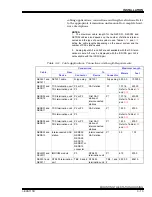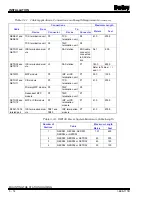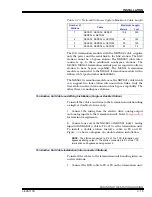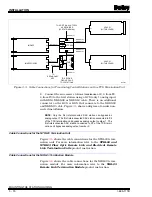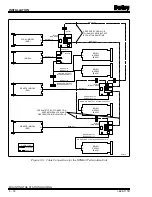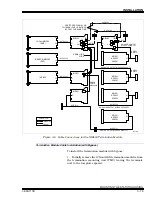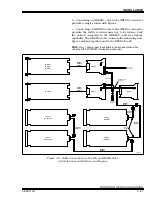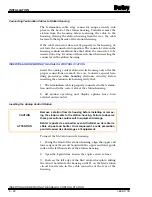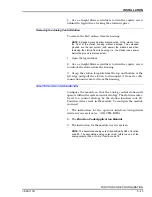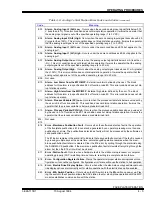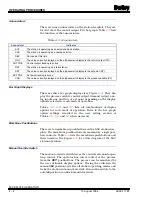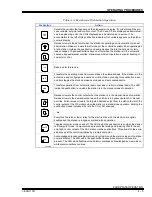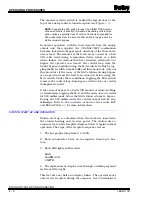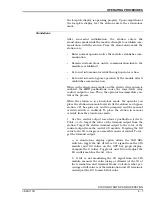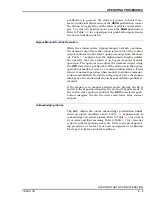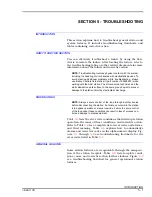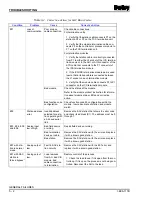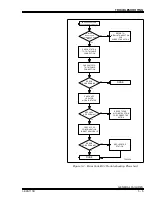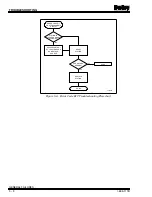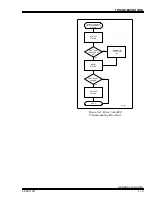
OPERATING PROCEDURES
FACEPLATE OPERATION
I-E96-117B
4 - 3
E03
Alarm - Analog Input 2 (AI2) Low - Occurs when the second analog input signal falls below 0.75
V (less than -5%). This error condition does not disrupt station operation. It warns the operator that
the analog input signal is out of the specified operating range (1 to 5 VDC).
E04
Alarm - Analog Input 2 (AI2) High - Occurs when the second analog input signal rises above 5.25
V (greater than 105%). This error condition does not disrupt station operation. It warns the operator
that the analog input signal is out of the specified operating range (1 to 5 VDC).
E05
Alarm - Analog Input 1 (AI1) Low - Occurs under the same conditions as E03 but applies to the
analog input 1.
E06
Alarm - Analog Input 1 (AI1) High - Occurs under the same conditions as E04 but applies to the
analog input 1.
E07
Alarm - Analog Output Low - Occurs when the analog output signal falls below 3 mA (less than
-5%). This error condition does not disrupt station operation. It warns the operator that the analog
output signal is out of the specified operating range (4 to 20 mA).
E08
Alarm - Analog Output High - Occurs when the analog output signal rises above 21 mA (greater
than 105%). This error condition does not disrupt station operation. It warns the operator that the
analog output signal is out of the specified operating range (4 to 20 mA).
E09
Not used.
E10
Alarm - Low Alarm from the MFC/MFP - External low alarm defined by the user. The block
address for this alarm is in specification S25 of function code 80. This error condition does not dis-
rupt station operation.
E11
Alarm - High Alarm from the MFC/MFP - External high alarm defined by the user. The block
address for this alarm is in specification S24 of function code 80. This error condition does not dis-
rupt station operation.
E12
Alarm - Process Variable (PV) Low - Occurs when the process variable falls below a value set by
the user in S8 of function code 80. This condition does not disrupt station operation. It warns the
operator that the process variable is below a predetermined limit.
E13
Alarm - Process Variable (PV) High - Occurs when the process variable rises above a value set
by the user in S7 of function code 80. This condition does not disrupt station operation. It warns the
operator that the process variable is above a predetermined limit.
E14 -
E15
Not used.
E16
Error - Membrane Pushbutton Fault - Occurs when the software detects a fault in the operation
of the frontplate pushbuttons. E16 can also be generated by an operator pressing more than one
pushbutton at a time. The pushbuttons detected as faulty will not be processed by the software as
valid pushbutton entries.
The E16 error remains in the alarm list to indicate that a keypad fault occurred. If the fault is caused
by pressing multiple keys at the same time, normal keypad operation resumes when the mem-
brane pushbutton fault alarm is cleared. Clear the E16 error by cycling through the alarm list using
the ALARM ACK pushbutton. If the membrane pushbutton fault still exists after cycling through the
alarm list, then the E16 error will not be cleared.
E17
Error - Station Fault - Occurs when a hardware fault in the station microprocessor or computer
operating properly (COP) watchdog time-out occurs, resulting in a complete station failure.
E18
Error - Configuration Register Failure - Warns the operator improper station microprocessor con-
figuration or it cannot be configured. Configuration error failure will cause the station to halt operation.
E19
Error - Electric Drive Display Option - Occurs when either the stand-alone or bypass/manual over-
ride display options are incorrectly set for station operation with the electric drive option enabled.
E20
Error - M/A Switch Position - Occurs when the M/A switch is in the M position on power up. Plac-
ing the switch in the
A position allows the SAC station to enter stand-alone operation until the MFP
module establishes communication with the station.
Table 4-2. Analog Control Station Error Codes and Alarms
(continued)
Code
Meaning
15 August 1994
I-E96-117B1


